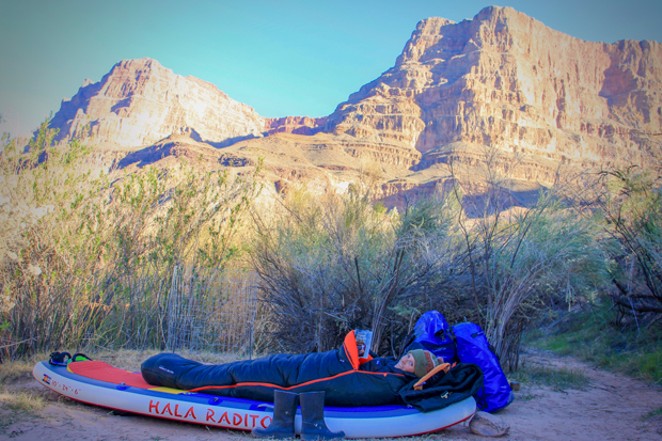Have you ever dreamt about paddling out to a distant shoreline or island and spending the night? If you have, then this article is for you! In a water wonderland like Central Oregon, where there's a secret lake around every corner, if you haven't slept out under the stars after a day of paddling, you haven't lived. Here's a checklist from yours truly and a quick shakedown of what to consider before your hydro-campout.

Gear
Besides the 10 essentials, ponder what you'll bring on your overnight via the water by packing like an ultralight backpacker. Stove: Jetboil; light: headlamp; warmth cocoon: feather-weight sleeping bag—no sleeping pad or tent required. Since it's summer, just pull your inflatable paddleboard on shore and crash on it. Pack all this in a 60- to 65-liter dry bag backpack. My favorite is made by Watershed. Pro tip: Although it will cost you in weight, if you want to have a late-night solo beachside dance party, I'd splurge and bring a waterproof Bluetooth speaker and maybe some battery-powered twinkle lights. Get it!For paddle-specific gear, choose a touring board, long and lean, something with D-rings or webbing to allow rigging gear to the bow and the stern of the board. On your person, I recommend Astral high-top water shoes and a rescue life jacket (it allows for great shoulder range of motion so as to avoid armpit chaffage), a sweet helmet, NRS guide shorts and sunshade hoody and obviously, a trucker hat. Don't forget a leash for your board and sunnies.
Provisions
If you're doing an overnight, you'll want to eat like a queen before your golden-hour dance party for one. Therefore, carb load. Good to-go freeze-dried meals are fantastically flavored and pretty healthful with gluten-free and vegan options, and easily accessible at places including Mountain Supply, your friendly neighborhood outdoor store. If you're on a shoestring budget, see Natural Grocers' bulk food section, with dried beans and soups of all sorts. For hydration, I prefer to pack in all my water, but gravity-fed filters and ultraviolet wands have become popular for purifying on the fly.When you eat and drink, a little while later, usually you have to go to the bathroom. With the increase in traffic on our waterways, even in spaces that you might feel are remote, it's good practice to pack out your doo-doo. I prefer to restroom in a wag bag, available for order on the NRS website and at all fine sporting-goods dealers. For the ladies, a shewee (or shenis, pee pal or freshette) can help you relieve your bladder while standing—a novel magic trick that brings a smile to my face every time.
Know before you go and logistics
So you've chosen a waterway for your adventure. Great. Now you need to:Be sure you've contacted the National Forest Service or Bureau of Land Management or whoever manages the waterway to check on hazards and access. No bigger bummer than showing up and a downed tree blocks the road so you can't get to the put-in. Check the internet, YouTube, local paddle shops and discover all known information about the location to which you are traveling. If you can, access and bring a map. Even a screenshot of Google maps will do. Or download any number of mapping apps that function without cell service. Finally, don't sandbag yourself. Do something simple and easy-ish for your first time out. No sense in ruining it so you never do it again.
Citizen stewardship
If you aren't familiar already, read about leaving no trace and Wild and Scenic river visitor expectations and practice these, even if the waterway isn't technically designated as such. Good manners and etiquette go a long way in karma, and you'll want the water Gods in your favor as you step up your hydro-expedition.Last and definitely, most certainly not least, remember native peoples as you navigate across water and wilderness; apps like Native Land will give you information on whose ancestral lands you are traveling.
Catch you out on the water!
Author K.M. Collins recently presented the talk,"Diving into Big Mile and Mutiday Paddleboarding on Wild & Scenic Rivers" in a Wild Wednesday Oregon Wild talk. See that webcast at OregonWild.org, and learn more about how Oregon Wild is going to bat for legislation to protect 4,700 Oregon river miles.








